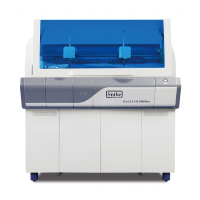
Do you have a question about the Snibe Maglumi 600 and is the answer not in the manual?
| Model | Maglumi 600 |
|---|---|
| Sample Types | Serum, Plasma, Whole Blood |
| Type | Chemiluminescence Immunoassay Analyzer |
| Weight | Approximately 150 kg |
| Power Supply | 220V, 50/60Hz |
| Time to first result | Approximately 15 minutes |
| Assay Method | CLIA |
| Reagent Cooling | 2-8°C |
| Sample Capacity | 60 samples |
| Reagent Capacity | 15 reagents on board |
| Detection Method | Photomultiplier Tube (PMT) |
| Throughput | 180 tests/hour |
| Test Menu | Wide range of infectious diseases, tumor markers, thyroid function, hormones, cardiac markers, etc. |
Describes how test calibrators are standardized against SNIBE internal reference substance.
Adjusts the master curve to a new measurement level with each calibration.
Lists conditions requiring recalibration, e.g., lot exchange or weekly.
Instructions for collecting, centrifuging, and storing serum samples.
Instructions for collecting, centrifuging, and storing plasma samples.
Details handling of human specimens, biohazards, and disposal of materials.
Covers avoiding expired kits, contamination, and proper reagent handling.
Emphasizes the need for clinical context and adherence to instructions for valid results.
Lists substances like bilirubin, hemoglobin, and triglycerides that do not interfere.
Explains potential interference from human anti-mouse antibodies (HAMA).
Describes automatic calculation via a calibration curve generated by the analyzer.
Provides reference values for serum and notes on inter-laboratory variations.
Evaluates intra-assay and inter-assay variability using control sera.
Defines sensitivity based on zero standard and standard deviation.
Assesses assay response to various potentially cross-reactive analytes.
Measures the accuracy of the assay by diluting known concentrations.
Checks the assay's linear response across a range of concentrations.
Compares MAGLUMI ALD results with a commercially available ALD test.
